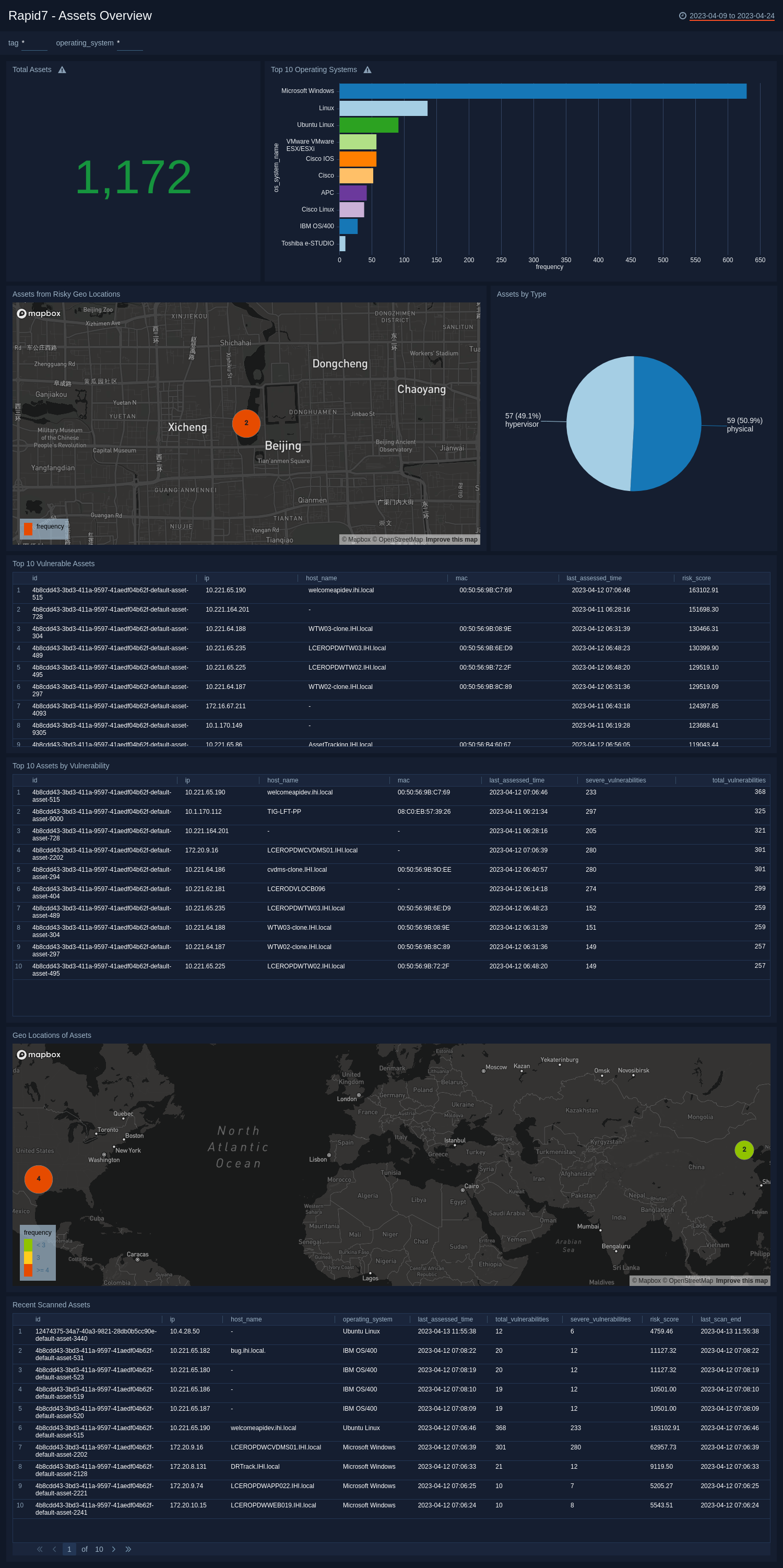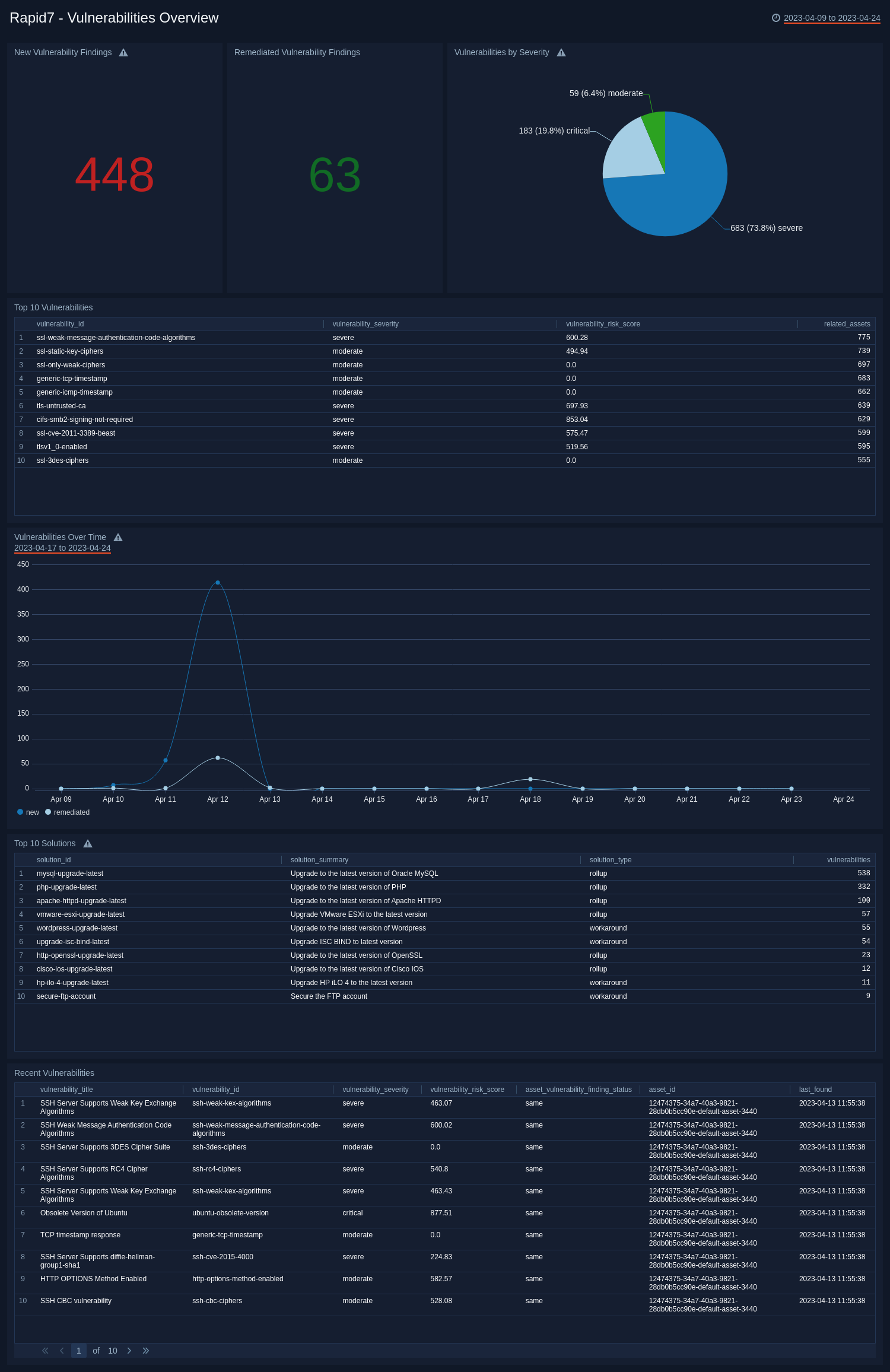Rapid7

The Sumo Logic app for Rapid7 enables you to gain deeper insights into asset and vulnerability management activities by collecting asset and vulnerability activities using Sumo Logic's cloud-to-cloud Rapid7 source.
Rapid7 app provides vital information, including asset count, distribution of assets based on risk score and type, and a detailed breakdown of vulnerabilities based on severity and status. This app also tracks the count of newly identified vulnerabilities, vulnerabilities based on severity, and the most frequently occurring vulnerabilities. Using this information, you can prioritize remediation efforts, minimize attack surfaces, and make well-informed decisions to enhance your overall security posture.
Log types
This app uses Sumo Logic’s Rapid7 Source to collect assets and vulnerabilities from Rapid7.
Sample log messages
{
"assessed_for_policies": false,
"assessed_for_vulnerabilities": true,
"credential_assessments": [
{
"port": 449,
"protocol": "TCP",
"status": "NO_CREDS_SUPPLIED"
},
{
"port": 445,
"protocol": "TCP",
"status": "NO_CREDS_SUPPLIED"
},
{
"port": 161,
"protocol": "UDP",
"status": "NO_CREDS_SUPPLIED"
},
{
"port": 23,
"protocol": "TCP",
"status": "NO_CREDS_SUPPLIED"
},
{
"port": 22,
"protocol": "TCP",
"status": "NO_CREDS_SUPPLIED"
}
],
"critical_vulnerabilities": 4,
"exploits": 1,
"host_name": "bld.ihi.local",
"id": "4b8cdd43-3bd3-411a-9597-41aedf04b62f-default-asset-370",
"ip": "10.221.64.100",
"last_assessed_for_vulnerabilities": "2023-04-12T06:58:24.911Z",
"last_scan_end": "2023-04-12T06:58:24.911Z",
"last_scan_start": "2023-04-12T06:30:07.616Z",
"mac": "6C:AE:8B:6A:5E:90",
"malware_kits": 0,
"moderate_vulnerabilities": 9,
"os_architecture": "",
"os_description": "IBM OS/400",
"os_family": "OS/400",
"os_name": "OS/400",
"os_system_name": "IBM OS/400",
"os_type": "",
"os_vendor": "IBM",
"risk_score": 13497.2060546875,
"severe_vulnerabilities": 12,
"tags": [
{
"name": "temp - colo discovery",
"type": "SITE"
},
{
"name": "vuln - lco (group 2) - unauthenticated",
"type": "SITE"
},
{
"name": "temp - discovery",
"type": "SITE"
}
],
"total_vulnerabilities": 25,
"type": "physical",
"unique_identifiers": []
}
{
"asset_id": "4b8cdd43-3bd3-411a-9597-41aedf04b62f-default-asset-519",
"check_id": null,
"finding_status": "remediated",
"first_found": "2023-02-01T07:51:38Z",
"key": "",
"last_found": "2023-03-29T06:52:25.006Z",
"port": null,
"proof": "<p><p>Able to determine system boot time.</p></p>",
"protocol": null,
"solution_fix": null,
"solution_id": null,
"solution_summary": null,
"solution_type": null,
"status": "VULNERABLE_EXPL",
"vulnerability_id": "generic-tcp-timestamp"
}
{
"added": "2018-02-06T00:00:00Z",
"categories": "XSS,jQuery",
"cves": "CVE-2015-9251",
"cvss_v2_access_complexity": "medium",
"cvss_v2_access_vector": "network",
"cvss_v2_authentication": "none",
"cvss_v2_availability_impact": "none",
"cvss_v2_confidentiality_impact": "none",
"cvss_v2_exploit_score": 8.588799953460693,
"cvss_v2_impact_score": 2.8627500620484354,
"cvss_v2_integrity_impact": "partial",
"cvss_v2_score": 4.3,
"cvss_v2_vector": "(AV:N/AC:M/Au:N/C:N/I:P/A:N)",
"cvss_v3_attack_complexity": "low",
"cvss_v3_attack_vector": "network",
"cvss_v3_availability_impact": "none",
"cvss_v3_confidentiality_impact": "low",
"cvss_v3_exploit_score": 2.8352547300000004,
"cvss_v3_impact_score": 2.7267508438373347,
"cvss_v3_integrity_impact": "low",
"cvss_v3_privileges_required": "none",
"cvss_v3_scope": "changed",
"cvss_v3_score": 6.1,
"cvss_v3_user_interaction": "required",
"cvss_v3_vector": "CVSS:3.0/AV:N/AC:L/PR:N/UI:R/S:C/C:L/I:L/A:N",
"denial_of_service": false,
"description": "jQuery before 3.0.0 is vulnerable to Cross-site Scripting (XSS) attacks when a cross-domain Ajax request is performed without the dataType option, causing text/javascript responses to be executed.",
"exploits": [],
"id": "jquery-cve-2015-9251",
"links": [
{
"href": "http://nvd.nist.gov/vuln/detail/CVE-2015-9251",
"id": "CVE-2015-9251",
"source": "cve"
},
{
"href": "http://rhn.redhat.com/errata/RHSA-2020-0729.html",
"id": "RHSA-2020:0729",
"source": "redhat"
},
{
"href": "http://rhn.redhat.com/errata/RHSA-2020-0481.html",
"id": "RHSA-2020:0481",
"source": "redhat"
},
{
"href": "http://www.securityfocus.com/bid/105658",
"id": "105658",
"source": "bid"
}
],
"malware_kits": [],
"modified": "2023-04-05T00:00:00Z",
"pci_cvss_score": 4.3,
"pci_fail": true,
"pci_severity_score": 3,
"pci_special_notes": "XSS vulnerabilities are a violation of the PCI DSS, and result in an automatic failure. ",
"pci_status": "fail",
"published": "2018-01-18T00:00:00Z",
"references": "bid:105658,cve:CVE-2015-9251,redhat:RHSA-2020:0481,redhat:RHSA-2020:0729",
"risk_score": 187.13,
"severity": "severe",
"severity_score": 4,
"title": "jQuery Vulnerability: CVE-2015-9251"
}
Sample queries
_sourceCategory="Rapid7" assessed_for_policies // fetches assets
| json "id", "type", "os_system_name", "risk_score", "host_name", "ip","severe_vulnerabilities", "total_vulnerabilities", "last_assessed_for_vulnerabilities", "mac", "last_scan_end", "tags[*].name" as id, type, operating_system, risk_score, host_name, ip, severe_vulnerabilities, total_vulnerabilities, last_assessed_time, mac, last_scan_end, tag_name_list nodrop
| extract field=tag_name_list "\"?(?<tag_name>[\w\s\-&.-z)(,]*?)\"?[,\n\]]" multi
| where tag_name matches "{{tag}}"
| where operating_system matches "{{operating_system}}"
| where !isNull(type)
|count_distinct(id) as frequency by type
| sort by frequency
_sourceCategory="Rapid7" (cvss_v2_access_complexity or asset_id)
| join
(json "id","severity","risk_score" as id, severity,risk_score) as vulnerability,
(json "vulnerability_id","asset_id","finding_status" as vulnerability_id, asset_id, finding_status) as asset_vulnerability
on vulnerability.id=asset_vulnerability.vulnerability_id // get information of asset related vulnerabilities from knowledge base
| fields vulnerability_severity, vulnerability_id, vulnerability_risk_score, asset_vulnerability_asset_id, asset_vulnerability_finding_status
| first(asset_vulnerability_finding_status) as aasset_vulnerability_finding_status group by vulnerability_id, asset_vulnerability_asset_id, vulnerability_severity, vulnerability_risk_score
| count_distinct(asset_vulnerability_asset_id) as related_assets by vulnerability_id, vulnerability_severity, vulnerability_risk_score
| sort by related_assets
| limit 10
Set up collection
To set up Cloud-to-Cloud Integration Rapid7 Source for the Rapid7 app, follow the instructions provided. These instructions will guide you through the process of creating a source using the Rapid7 Source category, which you will need to use when installing the app. By following these steps, you can ensure that your Rapid7 app is properly integrated and configured to collect and analyze your Rapid7 data.
Installing the Rapid7 app
To install the app, do the following:
- Select App Catalog.
- In the 🔎 Search Apps field, run a search for your desired app, then select it.
- Click Install App.
note
Sometimes this button says Add Integration.
- Click Next in the Setup Data section.
- In the Configure section of your respective app, complete the following fields.
- Key. Select either of these options for the data source.
- Choose Source Category and select a source category from the list for Default Value.
- Choose Custom, and enter a custom metadata field. Insert its value in Default Value.
- Key. Select either of these options for the data source.
- Click Next. You will be redirected to the Preview & Done section.
Post-installation
Once your app is installed, it will appear in your Installed Apps folder, and dashboard panels will start to fill automatically.
Each panel slowly fills with data matching the time range query and received since the panel was created. Results will not immediately be available, but will update with full graphs and charts over time.
Upgrading the Rapid7 app (Optional)
To update the app, do the following:
- Select App Catalog.
- In the Search Apps field, search for and then select your app.
Optionally, you can identify apps that can be upgraded in the Upgrade available section. - To upgrade the app, click Upgrade.
- If the upgrade does not have any configuration or property changes, you will be redirected to the Preview & Done section.
- If the upgrade has any configuration or property changes, you will be redirected to Setup Data page.
- In the Configure section of your respective app, complete the following fields.
- Key. Select either of these options for the data source.
- Choose Source Category and select a source category from the list for Default Value.
- Choose Custom and enter a custom metadata field. Insert its value in Default Value.
- Key. Select either of these options for the data source.
- Click Next. You will be redirected to the Preview & Done section.
- In the Configure section of your respective app, complete the following fields.
Post-update
Your upgraded app will be installed in the Installed Apps folder, and dashboard panels will start to fill automatically.
See our Release Notes changelog for new updates in the app.
Uninstalling the Rapid7 app (Optional)
To uninstall the app, do the following:
- Select App Catalog.
- In the 🔎 Search Apps field, run a search for your desired app, then select it.
- Click Uninstall.
Viewing Rapid7 dashboards
All dashboards have a set of filters that you can apply to the entire dashboard. Use these filters to drill down and examine the data to a granular level.
- You can change the time range for a dashboard or panel by selecting a predefined interval from a drop-down list, choosing a recently used time range, or specifying custom dates and times. Learn more.
- You can use template variables to drill down and examine the data on a granular level. For more information, see Filter with template variables.
- Most Next-Gen apps allow you to provide the scope at the installation time and are comprised of a key (
_sourceCategoryby default) and a default value for this key. Based on your input, the app dashboards will be parameterized with a dashboard variable, allowing you to change the dataset queried by all panels. This eliminates the need to create multiple copies of the same dashboard with different queries.
Assets Overview
The Rapid7 - Assets Overview dashboard provides a detailed summary of the assets within the Rapid7 source. It presents a comprehensive view of the total asset count, highlighting the top 10 vulnerable assets based on their risk score and the number of associated vulnerabilities. Additionally, this dashboard offers valuable information about the leading operating systems among assets, the distribution of assets by type, the geographic location of assets, and a summary of recent assets based on their most recent scan time.
Vulnerabilities Overview
The Rapid7 - Vulnerabilities Overview dashboard offers significant insights into vulnerability findings from the assets. It tracks the number of new and remediated vulnerability findings over the period. The dashboard includes visual representations of vulnerabilities categorized by severity and highlights the top 10 vulnerabilities related to assets. Additionally, it presents a summary of the leading 10 solutions utilized to address vulnerabilities and showcases recent vulnerability instances based on their most recent discovery time, along with information on the assets involved.